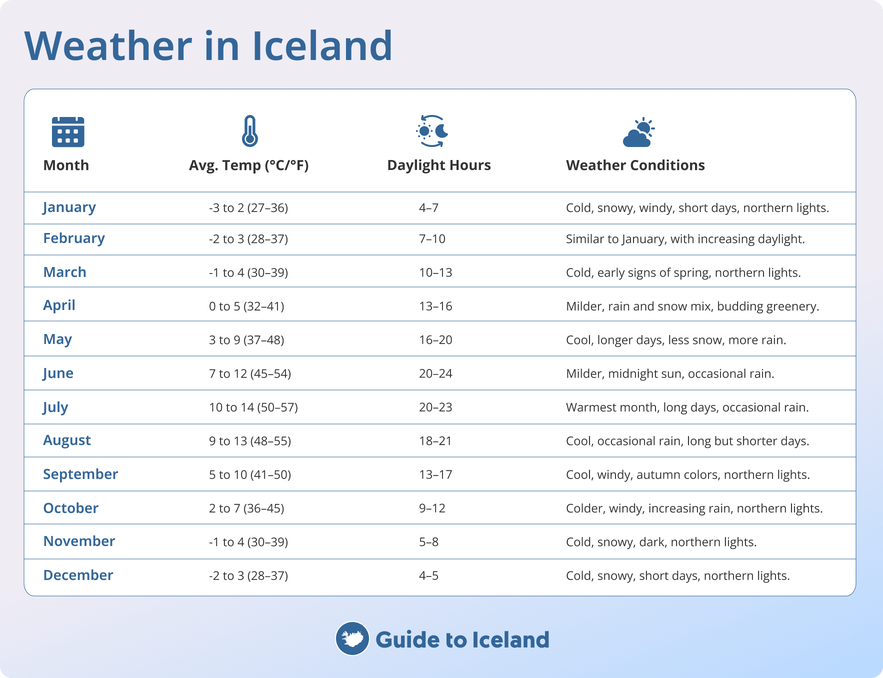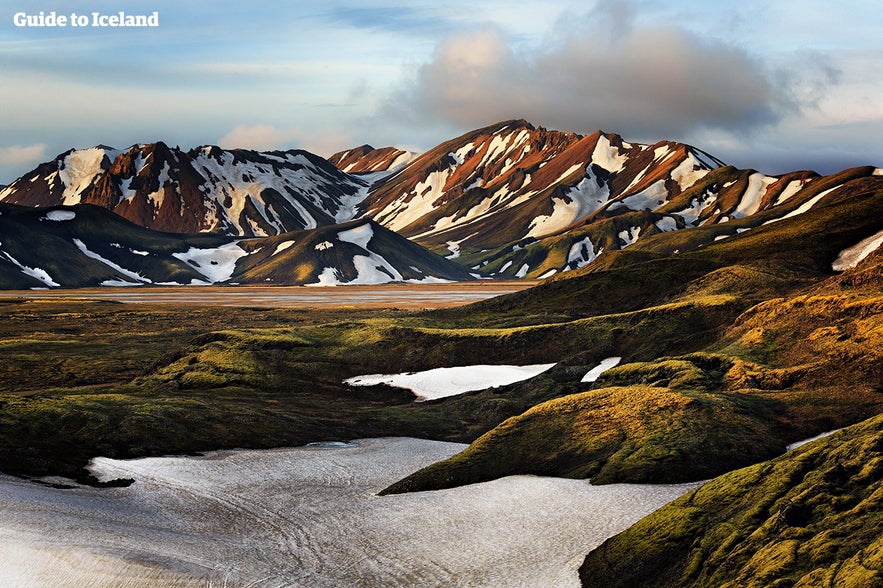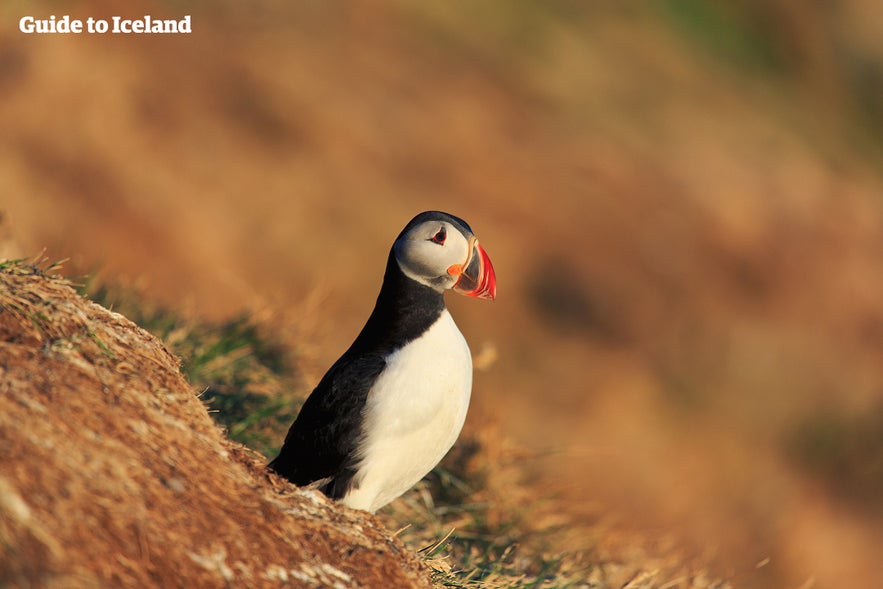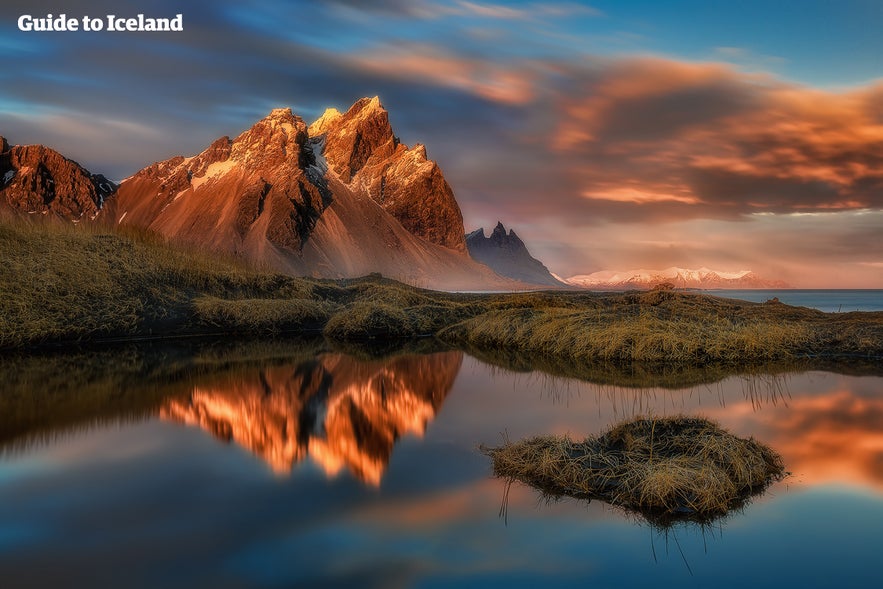One of the first questions people ask when considering a trip to Iceland is, "When is the best time to visit Iceland?" It's hard to answer because Iceland is so varied in nature and wildlife, and the weather in Iceland is so unpredictable. Your experience when visiting Iceland can be completely different depending on what time of year you visit.
If you want the best weather for self-drive tours in Iceland and exploring nature with a rental car, then summer is your go-to time. If you want to see the northern lights, however, then winter vacations are the only option.
Why You Can Trust Our Content
Guide to Iceland is the most trusted travel platform in Iceland, helping millions of visitors each year. All our content is written and reviewed by local experts who are deeply familiar with Iceland. You can count on us for accurate, up-to-date, and trustworthy travel advice.
Ultimately, the best time to visit Iceland depends on what you want to experience. No matter when you choose to go, planning a fun itinerary, booking good Iceland accommodations, and packing the right things will make all the difference. Read on for all you need to know about the weather and temperature in Iceland to plan the perfect trip!
- Discover How Many Days to Spend in Iceland
- Also, learn What To Pack for Iceland for All Seasons
Key Takeaways
-
Iceland’s weather is famously unpredictable. Sun, rain, and snow can all happen in a single day.
-
Average temperatures range from around 30 F (-1 C) in winter to 52 F (11 C) in summer.
-
Daylight shifts fast, with 4 to 5 hours in December and 21 hours by late June.
-
The wind and chill can make it feel colder than it is, especially by the coast.
-
Pack for layers and waterproof everything, no matter the season.
-
The best time to visit Iceland depends on what you want to see and do. Summer is best for road trips and hiking. Meanwhile, winter is ideal for northern lights and ice cave tours
There's No Wrong Time to Visit Iceland!
It's true! While the weather and seasons in Iceland vary significantly throughout the year, Iceland is one of the most exciting countries to visit for nature lovers. There is fantastic natural beauty to take in all 12 months of the year. Summer will bring the midnight sun, and winter will bring the gorgeous northern lights.
Some experiences available in December aren't available in June - and vice versa. In June, you can experience the midnight sun, see puffins, enjoy generally warmer temperatures, go camping, and more.
In contrast, December brings out the options of northern light tours, ice cave tours, the magical twinkly lights of the Icelandic Christmas season, and more. No one season holds all the activities Iceland has to offer. There is truly something for everyone in every season.
Visiting Iceland during the off-season is a better time for encountering fewer crowds. Summer is typically the busiest season, but you can still find wide-open spaces to explore, even during this period. The activities are so nature-focused that you can always find a way to avoid the crowds.
What's the Weather Like in Iceland?
 Iceland does have four seasons, although sometimes it doesn't feel that way. The weather changes all the time! This means Iceland's weather year-round is prone to many changes and surprises.
Iceland does have four seasons, although sometimes it doesn't feel that way. The weather changes all the time! This means Iceland's weather year-round is prone to many changes and surprises.
You'll probably hear the joke "if you don't like the weather, wait five minutes!" when you're in Iceland. Many people think that Iceland is constantly frozen, but that is not the case.
Understanding the Climate in Iceland
 Iceland enjoys a much milder climate than its name suggests. This is partly due to the Gulf Stream that flows along the west and south of Iceland, bringing warmth from the Caribbean.
Iceland enjoys a much milder climate than its name suggests. This is partly due to the Gulf Stream that flows along the west and south of Iceland, bringing warmth from the Caribbean.
This warmth also means that the mild Atlantic air gets mixed with the cold Arctic air coming from the north and causes sudden and frequent weather changes.
Therefore, there is a lot of wind and stormy weather. Precipitation is also high, while the southern part of the country usually gets more rainfall than the north.
Another reason for the warmth in Iceland is that Iceland sits on top of one of the Earth's hot spots. Iceland is a country of incredible geothermal power. You can bathe in hot springs, see erupting geysers, visit volcanoes, and feel occasional earthquakes.
Iceland is one of the few places in the world where you can see two tectonic plates meet on the Earth's surface, as they usually meet under the sea.
Iceland is divided by the Eurasian and the North American tectonic plates. The divide runs through the country's middle and is visible at Thingvellir National Park. You can even go diving or snorkeling between the two continents in the Silfra fissure! These tectonic movements will split Iceland into two in a few billion years. But until then, let's make the most of it!
- Learn about Earthquakes in Iceland
- See also: Tectonic Plates in Iceland and Where to Find Them
Don't be put off by volcanic activity or earthquakes in Iceland. When a volcano starts erupting, it tends to become an attraction instead of a reason for people to flee. Earthquakes are generally very minor, and larger events are very rare.
Regional Weather Conditions in Iceland
Iceland's climate shifts noticeably depending on where you are. Knowing what to expect in each region makes it easier to plan your itinerary and stay safe throughout the year.
Reykjavik Weather

The weather in Reykjavik averages around 23-35,6 F (-5-2 C ) in wintertime and 54-60 F (12-15 C ) in summer.
In the summer, temperatures can fluctuate, sometimes dropping to 44 F (7 C) or reaching up to 77 F (25 C) on particularly warm days. During winter, temperatures can dip as low as 14 F (-10 C), though milder days may see highs of 50 F (10 C).
Reykjavik generally enjoys milder conditions compared to more northern parts of Iceland, where temperatures can vary more dramatically.
North Iceland Weather
Summers in North Iceland tend to be warmer but shorter than along the South Coast. Even during the summer months, chilly days can occur, especially in the Highlands.
Winters in North Iceland are colder, with average temperatures hovering around 32 F (0 C), though they can drop as low as 5 F (-15 C). The winter also brings more consistent snow, making it ideal for winter sports and creating a true winter landscape. It's no surprise then that the largest town in the region, Akureyri, is considered the best place for skiing in Iceland.
Iceland Westfjords Weather
 Summers in the Westfjords of Iceland tend to be cooler and shorter compared to other parts of the country, with average high temperatures around 50 F (10 C) in July, the warmest month. However, even during summer, conditions can be unpredictable, with occasional rain or chilly winds.
Summers in the Westfjords of Iceland tend to be cooler and shorter compared to other parts of the country, with average high temperatures around 50 F (10 C) in July, the warmest month. However, even during summer, conditions can be unpredictable, with occasional rain or chilly winds.
Winters in the Westfjords can be harsh, with some towns becoming inaccessible due to heavy snowfall. It's best to leave Westfjord tours for the summertime, so you don't have to worry about weather delays.
Understanding Weather Forecasts in Iceland
 Iceland’s weather can change fast, sometimes several times in one day. That’s why learning how to read local forecasts is one of the smartest things you can do as a traveler. Once you know what to look for, planning your day and staying safe becomes much easier.
Iceland’s weather can change fast, sometimes several times in one day. That’s why learning how to read local forecasts is one of the smartest things you can do as a traveler. Once you know what to look for, planning your day and staying safe becomes much easier.
Wind Warning System in Iceland
 Wind in Iceland isn’t just something you feel. It’s something you need to plan for. Gusts can come out of nowhere and hit hard. That’s why Iceland uses a color-coded wind warning system to help both locals and travelers stay safe on the road.
Wind in Iceland isn’t just something you feel. It’s something you need to plan for. Gusts can come out of nowhere and hit hard. That’s why Iceland uses a color-coded wind warning system to help both locals and travelers stay safe on the road.
The system is managed by the Icelandic Meteorological Office (IMO). It works kind of like a traffic light:
-
Yellow means be careful, especially if you’re driving a camper van or SUV.
-
Orange means strong winds are expected, and travel might be tricky.
-
Red means stay put. Winds are dangerous, and conditions could be life-threatening.
These alerts are region-specific, which means one area can be calm while another gets hit with storm-force winds. The forecasts include maps, wind speed charts, and updates every few hours. You can find them on the IMO website, local news, or even at your hotel desk.
Wind is most common in winter and spring, but it can happen any time of year. A clear sky doesn’t mean a calm day. Keep in mind that strong gusts can still make driving risky.
If you're renting a car, ask your rental company or accommodation staff to point out current warnings. They often help people understand when to head out, or when to wait it out with a warm drink instead.
Snow and Icy Conditions in Iceland
 Snow is a big part of life in Iceland for much of the year. It can arrive in the fall and stay into late spring, especially in the north and highlands. Even in cities like Reykjavik, a heavy snowstorm can show up overnight. And ice, especially black ice, is common and can be hard to spot.
Snow is a big part of life in Iceland for much of the year. It can arrive in the fall and stay into late spring, especially in the north and highlands. Even in cities like Reykjavik, a heavy snowstorm can show up overnight. And ice, especially black ice, is common and can be hard to spot.
How to Read the Snow Forecast
Snow and ice are shown clearly in Icelandic weather forecasts on vedur.is. You can see maps with snowfall amounts and timelines.
Look for color-coded snow maps. Light colors usually mean light snow, and darker shades show where heavy snow is expected. The forecast also includes temperature maps, which help spot areas at or below freezing, where ice may form.
Forecasts are updated several times each day, so it’s smart to check again before heading out. Pay special attention to morning and evening forecasts, when surfaces freeze more easily.
What to Know About Black Ice
Black ice is a thin, nearly invisible layer of ice that often forms when temperatures hover around 32 F (0 C). It’s especially common:
-
On roads, sidewalks, and steps
-
In shaded spots, bridges, or hills
-
During early mornings and late evenings
Even if the road looks wet, it might be icy. Walk carefully and wear boots with a good grip. If you’re driving, slow down and give yourself extra time.
Snow and Ice Travel Tips for Iceland
From October to April, winter tires are a must, and a 4x4 vehicle is strongly recommended. Some mountain roads or rural areas, like the Westfjords, may close during storms or become unreachable until they’re cleared.
Check road.is for real-time road conditions, snow alerts, and webcam views of popular routes. The site also marks roads that are icy, snowy, or fully closed.
If snow or ice is in the forecast, consider changing your plans. Locals do the same. It’s normal to wait out a storm and head out when it’s safe again.
Rain and Flooding Risk in Iceland
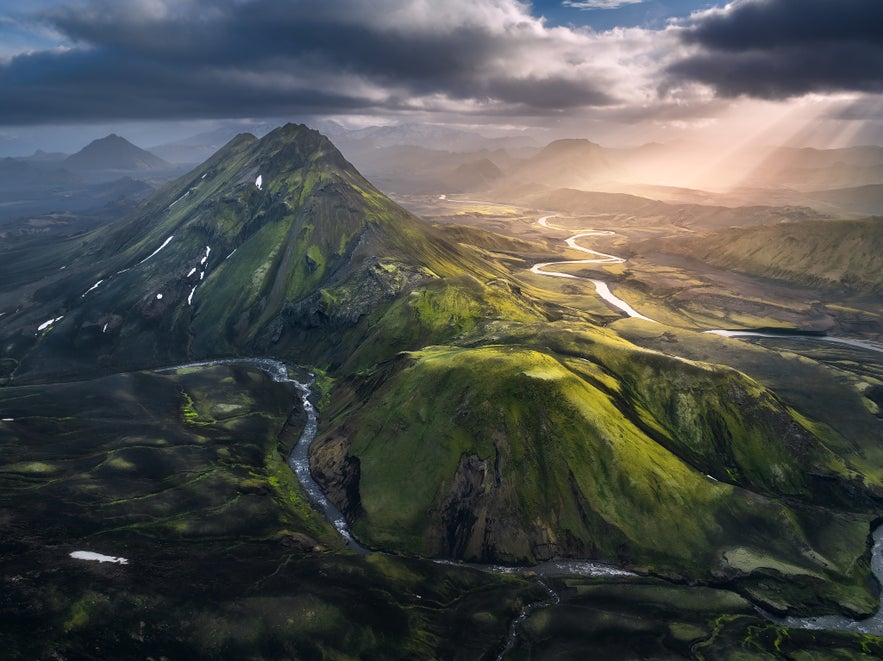 Rain is common in Iceland and can happen at any time of year. It might come as light drizzle or sudden heavy showers, especially along the south coast and in Reykjavik. Even in summer, it’s normal to get a short burst of rain during an otherwise sunny day. That’s why waterproof clothing is a must for everyone.
Rain is common in Iceland and can happen at any time of year. It might come as light drizzle or sudden heavy showers, especially along the south coast and in Reykjavik. Even in summer, it’s normal to get a short burst of rain during an otherwise sunny day. That’s why waterproof clothing is a must for everyone.
Reading the Rain and Flood Forecast in Iceland
The Icelandic Meteorological Office shows rain forecasts by area on vedur.is. Maps and charts show how much rain is expected and when. Rainfall is measured in millimeters, and the color scale makes it easy to spot heavier rain zones. If dark colors are over your location, bring full rain gear or adjust your plans.
Look at the timing, too. Some days start clear but have rain moving in by afternoon. Forecasts update often, so check again in the evening if you’re planning for the next day.
Flooding in Iceland
Most of the time, rain runs off quickly. But after several hours or days of rain, rivers can rise fast, especially in low valleys or near steep hills. This is more likely in the south and during spring melt or warm spells.
Forecasts may also include flood alerts, especially during long rain events or in areas with snowmelt. In rare cases, Iceland can have glacial floods (jökulhlaups), but these are monitored closely and warnings are given well in advance.
In cities like Reykjavik, flooding sometimes happens in winter when heavy rain falls on frozen ground. The water can’t soak in, so it may collect on roads or sidewalks.
How to Stay Safe When It Rains in Iceland
During or after heavy rain, it’s important to avoid crossing rivers or streams, as water levels can rise quickly and become dangerous. If rain is in the forecast, skip hikes in flood-prone areas and choose safer paths. Always check local alerts and travel warnings on websites like vedur.is.
If you’re planning to drive, don’t assume that all roads are safe to use. Some routes may flood, and F-roads, which are mountain tracks, can become especially risky when rivers swell. Before heading out, check current road conditions on road.is.
UV Index and Sunlight Hours in Iceland
 The sun in Iceland might not feel strong, but don’t let the cool air fool you. On bright summer days, the UV index can climb to around 6 in Reykjavik, especially between noon and 2 in the afternoon.
The sun in Iceland might not feel strong, but don’t let the cool air fool you. On bright summer days, the UV index can climb to around 6 in Reykjavik, especially between noon and 2 in the afternoon.
That means sunburn is still possible, even if you’re bundled up in a jacket. Early mornings and evenings are much gentler, with lower UV levels around 1 or 2. Still, sunscreen is smart if you’ll be outdoors during the middle of the day, even when it’s cloudy.
Sunlight Hours in Iceland Across the Year
Summer in Iceland is full of light. In June, the sun almost never sets. Around the summer solstice, Reykjavik gets up to 21 hours of sunlight. It stays bright late into the night, so you can take a walk at midnight and still see clearly.
In winter, daylight is short. In December, there may be only 4 to 5 hours of light. The sun rises late, stays low in the sky, and sets by early afternoon. These short days are good for slower adventures, like relaxing in a hot spring or watching for the northern lights.
The amount of daylight has a big impact on what you can do. Summer is great for hiking, long drives, and exploring without worrying about sunset. Winter is quieter, with shorter outings and more time indoors.
Always check both the UV forecast and sunlight hours before heading out. A bit of sunscreen and a flexible plan will help you enjoy whatever the day brings.
Cloud Forecasts for Aurora Viewing in Iceland
 When it comes to seeing the northern lights in Iceland, the sky matters just as much as solar activity. Even strong aurora displays won’t break through a solid cloud layer. That’s why checking the cloud cover forecast is one of the most important things you can do before heading out.
When it comes to seeing the northern lights in Iceland, the sky matters just as much as solar activity. Even strong aurora displays won’t break through a solid cloud layer. That’s why checking the cloud cover forecast is one of the most important things you can do before heading out.
How to Read the Cloud Forecast
The Icelandic Meteorological Office has a helpful cloud cover map that shows where the skies are clear. On the map, white areas mean clear skies, green means cloud cover, and light green means partial clouds.
If you see a patch of white over your location, that means clear skies and a good chance to spot the aurora. Even if most of the map is green, it’s still worth trying. When aurora activity is strong and there’s a break in the clouds, you might still get to see the lights.
Forecasts are updated daily, usually in the evening. Many travelers check them around 6 PM to decide if it’s worth driving out that night. Because the weather in Iceland changes fast, it helps to stay flexible and be ready to move to a clearer area nearby.
What Else to Watch for Northern Lights Viewing in Iceland
For the best chance of spotting auroras, you’ll want to check more than just cloud cover. The Kp-index shows the strength of geomagnetic activity. It’s rated from 0 to 9. A reading of 4 or higher is great, but even a 2 or 3 can bring visible lights if the sky is dark and clear.
Also, try to get away from city lights. Rural areas or places with little light pollution will always give you better views. Some travelers even camp near their viewing spots or stay in countryside cabins where they can check the sky from the front porch.
Volcanic Activity and Gas Emissions in Iceland
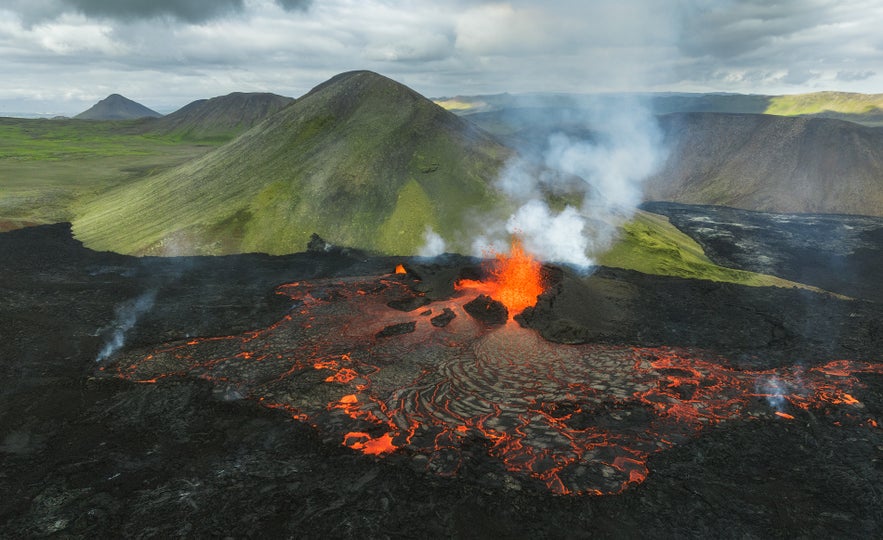
When a volcano is active in Iceland, it can release gases. It’s usually not a problem, but they can affect air quality near the eruption site or in areas where the wind carries them.
The Icelandic Meteorological Office shows gas forecasts on vedur.is. On the map, green means low risk, and yellow or orange means higher levels. If gas levels are high in your area, it’s a good idea to stay indoors and keep windows closed.
These gas forecasts are most useful if you're planning to visit active areas or take part in outdoor activities nearby. If conditions change, local authorities may advise avoiding certain spots or spending less time in affected zones. You'll also see these updates shared by tour companies, hotels, and on local news.
Iceland is very safe to visit, even when a volcano is active. Forecasts help locals and visitors stay informed, just like wind or rain reports. If you check daily weather updates and follow local guidance, you’ll be free to explore Iceland’s stunning volcanic landscapes with confidence.
What's the Best Season to Visit Iceland?

Summer is the country's high season and the most popular time to come to Iceland. Iceland's summer weather is milder, the days are longer, and it's a truly spectacular time to visit. If you're coming to Iceland for the first time, we recommend doing so in the summertime.
If you are coming to Iceland for the second or third time, we'd recommend checking out one of the other seasons.
The prices will be lower for your accommodation (except for Christmas and New Year's Eve!) as it is the low season, but you will see a great contrast to the summer landscapes.
Some attractions are only available during the winter, such as the elusive northern lights and the spectacular ice caves in Iceland's many glaciers.
You could also find yourself on a crazy adventure that includes super jeeps and snow blizzards and come home with slightly more fun and exciting travel stories than usual. And nothing beats New Year's Eve in Reykjavik!
For updated information about Iceland's climate and weather conditions, visit the Icelandic Meteorological Office website, vedur.is.
Just remember that the weather in Iceland can be highly unpredictable (even in the summer), so all forecasts should be considered best guesses.
Spring Weather in Iceland
While spring in Iceland comes in April and May, Icelanders celebrate the first day of summer on the first Thursday after April 18. It's the 'official' first day of summer and a public holiday. It's also not that uncommon for snow to fall on this day.
Though this is considered the first summer day, it would be more accurate to say it's the first spring day.
Iceland can sometimes have snowfall during April and May, but generally, this is when the snow melts in the mountains and highlands, allowing the flowers of Reykjavik and its coastline to start blooming.
Spring is also when migrating birds appear in Iceland, such as the famous puffins. The first puffins return in April and stay until September.
Another bird, the golden plover, is supposed to bring spring along with it. You can see the first golden plovers towards the end of March.
- See also: Icelandic Birdlife
Springtime weather in Reykjavik can be anything from snow, sleet, and rain, to bright sunny days. Iceland's average temperature in spring is between 32-50 F (0-10 C). Springtime can be wet in the southern part of the country but drier (and colder) in North Iceland.
The Icelandic Highlands are colder than the coastline and are closed to traffic during the spring. The colors of nature will start to emerge at this time. The grass may not be very tall or green yet, but tree leaves will be close to returning.
Spring flowers such as crocus and Easter lilies will begin poking their heads out of people's gardens. You might even see some spring flowers blossom on tree branches.
Generally, the end of winter lifts people's spirits, and there's excitement in the air for the summer that's around the corner.
Spring is an excellent time for tourists to come to Iceland. You can still catch the northern lights, the weather is mild, and the high season hasn't started yet, so fewer tourists are around and lower prices.
It should also be easier for you to find accommodation and tour availability.
Summer Weather in Iceland - The Most Popular Season
Iceland's summer starts in late May or early June and lasts through August. It's the most popular time for people to visit Iceland.
The midnight sun appears, meaning the days are incredibly long. The longest days last close to 21 hours until the sun sets. Therefore, if you rent an affordable car in Iceland, you will have the freedom to explore the country around the clock!
- See more: Best Advice For Renting a Car in Iceland
The days get longer and longer until the solstice falls around June 21st. The days get shorter after the summer solstice, but only by a minute or two each day. The sunsets turn into sunrises in spectacular shows of color that can last for hours. Iceland is a paradise for photographers who want to capture nature during the "golden hour."
- See also: Photography in Iceland
These long days with fair Icelandic summer temperatures are convenient for travelers; you won't ever get lost in the dark or need to reach a destination before night falls.
There is no complete darkness! Don't worry, you'll still be able to sleep. Just use blackout curtains or pack an eye mask to wear to bed.
Most tours are available in the summertime. You'll be able to see many locations during the long days, including mountains, glaciers, volcanoes, and waterfalls. These will provide you with excellent color contrasts.
The best weather in Iceland occurs in the summer, however, it can still be unpredictable. Summers are not as wet as spring, but it does rain occasionally. The wind chill can make summer days and nights cool, as Iceland is very windy. If you're lucky, you'll get to experience warm days during the summer in Iceland.
Plenty of festivals in Iceland occur during the summer, and many people choose to travel around the country and camp. Summer festivals include the Lobster Festival, Irish Days, the Eistnaflug Festival, and many smaller events.

Towards the end of June or the beginning of July, some Highland roads are opened after being closed for the winter.
This is the only time of year you can access the famous areas of Landmannalaugar and the Thorsmork valley. If you dream of hiking in Iceland on the popular Laugavegur and Fimmvorduhals routes, July or early August is the best time to do so.
Fall Weather in Iceland
In Iceland, autumn starts in late August and lasts until late October or early November. Autumn is a great time to visit Iceland as it's still relatively warm in late August, though as each day passes, it gets colder.
Prices for accommodations go down in September and October, and you'll be able to see Iceland's gorgeous fall colors. Maybe you'll experience the first snowfall of the year or catch the northern lights.
The only downfall is that it may be windy, wet, and possibly quite cold.
Fall in Iceland is similar to springtime, between 32-50 F (0 to 10 C), though autumn feels windier. This may be because of all the leaves falling from the trees and blowing in the wind. There will still be days like the one seen in the picture above, taken at Thingvellir National Park.
When there is a fresh layer of snow mixed in with the autumn colors of the moss and the lava, you'll see some incredible color combinations, such as the picture of Hraunfossar below.

Autumn is when the birds start flying south, and some experiences, such as river rafting tours or Highland excursions, close for the season.
This is also when you'll be able to go mushroom or berry picking in the countryside. You can find wild blueberries, crowberries, and strawberries in Iceland. Redcurrants are also available, though they are mainly planted and found in people's gardens. Always keep your eyes on the night skies during this time, as you can start spotting the northern lights!
Winter Weather in Iceland
 Winter in Iceland is the longest season and generally lasts from November until March. These are the darkest months of the year, with little sunlight. You may then be wondering if Iceland is worth visiting in winter. The simple answer is yes!
Winter in Iceland is the longest season and generally lasts from November until March. These are the darkest months of the year, with little sunlight. You may then be wondering if Iceland is worth visiting in winter. The simple answer is yes!
The year's shortest day happens just before the Christmas holidays, on December 21st. On that day, there are only 4-5 hours of daylight.
Fortunately, Christmas in Iceland is filled with twinkling fairy lights in every garden and on every street, so it is a thoroughly cozy and lovely place to be.
 Winter is a great time to cuddle up indoors over a nice cup of hot chocolate or bathe in one of Iceland's many hot tubs, hot pools, or hot springs. It’s also the ideal season for unforgettable winter activities in Iceland, such as glacier hiking, northern lights tours, and exploring natural ice caves.
Winter is a great time to cuddle up indoors over a nice cup of hot chocolate or bathe in one of Iceland's many hot tubs, hot pools, or hot springs. It’s also the ideal season for unforgettable winter activities in Iceland, such as glacier hiking, northern lights tours, and exploring natural ice caves.
While some hot springs are open year-round, their warm waters feel especially soothing during the colder months. Winter’s freezing temperatures transform flowing glacial rivers into solid ice, revealing the stunning blue ice caves beneath Vatnajokull, Europe’s largest glacier. It’s one of the best winter tours in Iceland that you won’t find in summer.

You can see the Icelandic glaciers all year round, and they can be breathtaking in contrast to the summer colors. But it is in the winter that they become truly spectacular.
Contrary to many people's beliefs, snow is not always covering Iceland during winter. The snow appears, melts, and appears again, so you can still see the contrast of colors and get a sense of the glaciers' incredible size.
Winter is Iceland's most unpredictable season when it comes to the weather.
Winter is the coldest season, but it may not be as cold as you imagine. If you are somewhere in the south, such as Reykjavik, the average temperature is around 32 F (0 C). It can go down to 23 F (-5 C) or up to 41 F (5 C), but usually doesn't get much colder or warmer than that, though you should always consider the wind chill.
If you're wondering when it snows in Iceland, then winter will be the logical answer. Anywhere from October to April can experience snowfall, with the heaviest being received between late December and February.
The Highlands are closed during the wintertime, but you can take adventurous glacier hiking tours. Tours depend on weather and visibility, so be aware that they can be canceled with just a few hours notice. When an operator cancels a tour, they will offer you another tour in return or a full refund.
These precautions mean you won't find yourself on top of a glacier in a crazy snowstorm. The best advice we can give you is to bring many warm layers, preferably made of wool or fleece. That way, you can always add a layer or take a layer off to make sure you are comfortable.
Temperature and Weather in Iceland by Month
| Month | Fahrenheit | Celsius |
|---|---|---|
| January | 33 F° | 1 C° |
| February | 33 F° | 1 C° |
| March | 34 F° | 1 C° |
| April | 39 F° | 3 C° |
| May | 44 F° | 7 C° |
| June | 50 F° | 10 C° |
| July | 53 F° | 12 C° |
| August | 52 F° | 11 C° |
| September | 47 F° | 8 C° |
| October | 41 F° | 8 C° |
| November | 36 F° | 2 C° |
| December | 33 F° | 1 C° |
Iceland’s weather changes dramatically throughout the year, with each month bringing its own mix of daylight, temperatures, and conditions. Here’s what to expect from Iceland's weather by month.
Iceland Weather in January
 January in Iceland brings true winter conditions, with short days, snowy landscapes, and a good chance of spotting the northern lights. In Reykjavik, temperatures usually range between 23 F and 34 F (-5 C to 1 C), though it can feel colder with the wind. Outside the city, conditions vary. The north and highlands are often colder and snowier than the south.
January in Iceland brings true winter conditions, with short days, snowy landscapes, and a good chance of spotting the northern lights. In Reykjavik, temperatures usually range between 23 F and 34 F (-5 C to 1 C), though it can feel colder with the wind. Outside the city, conditions vary. The north and highlands are often colder and snowier than the south.
This month is often wet, with snow, rain, sleet, and wind. Storms can happen, so check the weather forecast before going outside. Watch for wind and snow warnings, especially if you're driving or leaving town.
Iceland Weather in February
 February in Iceland continues the deep winter season with cold temperatures, snowy landscapes, and a mix of unpredictable weather. In Reykjavik, the average temperature hovers around 34 F (1 C), though it often feels colder with wind and damp air. In the north and rural areas, it’s usually chillier, with more snow on the ground.
February in Iceland continues the deep winter season with cold temperatures, snowy landscapes, and a mix of unpredictable weather. In Reykjavik, the average temperature hovers around 34 F (1 C), though it often feels colder with wind and damp air. In the north and rural areas, it’s usually chillier, with more snow on the ground.
February brings about 3.3 inches (83 mm) of precipitation, often mixing rain, snow, sleet, and wind in a single day. Icy roads and sidewalks are common, especially early or late in the day, so checking forecasts is key.
Iceland Weather in March
 March in Iceland brings longer days but still feels like winter. In Reykjavik, temperatures usually range from 28 F to 37 F (-2 C to 3 C). Snow, ice, and wind are still common, especially in the north, while rain becomes more frequent as the month progresses.
March in Iceland brings longer days but still feels like winter. In Reykjavik, temperatures usually range from 28 F to 37 F (-2 C to 3 C). Snow, ice, and wind are still common, especially in the north, while rain becomes more frequent as the month progresses.
Though storms are less frequent than in mid-winter, weather can still change quickly. You might start the day with clear skies and end it in sleet or strong winds.
Iceland Weather in April
 April in Iceland is a mix of seasons. Temperatures usually sit between 39 F and 44 F (3 C to 6.8 C), with Reykjavik a bit warmer than rural areas. You might see snow, rain, or sun, sometimes all within hours. Rainfall begins to ease, but the weather can still shift quickly.
April in Iceland is a mix of seasons. Temperatures usually sit between 39 F and 44 F (3 C to 6.8 C), with Reykjavik a bit warmer than rural areas. You might see snow, rain, or sun, sometimes all within hours. Rainfall begins to ease, but the weather can still shift quickly.
Locals say April teases spring, then surprises you with a snowstorm. You'll notice melting snow, patches of green, and chilly winds, especially in open spaces.
Iceland Weather in May
 May in Iceland brings milder days and fewer storms. Temperatures range from 36 F (2 C) early in the month to 53 F (11 C) later on. Snow is rare, though mountaintops may stay white. Rain and wind still pop up, so pack layers and waterproof gear.
May in Iceland brings milder days and fewer storms. Temperatures range from 36 F (2 C) early in the month to 53 F (11 C) later on. Snow is rare, though mountaintops may stay white. Rain and wind still pop up, so pack layers and waterproof gear.
Daylight stretches fast, from 18 hours in early May to nearly 21 by the end of the month. Nights never get fully dark. This means you won’t see the northern lights, but you’ll have plenty of time to explore.
Iceland Weather in June
 June in Iceland brings mild temperatures, long daylight hours, and low winds. Average temperatures hover around 50 F (10 C), making it one of the warmest months of the year. While light rain is still possible, the weather is generally pleasant and stable.
June in Iceland brings mild temperatures, long daylight hours, and low winds. Average temperatures hover around 50 F (10 C), making it one of the warmest months of the year. While light rain is still possible, the weather is generally pleasant and stable.
The real highlight is the near 24-hour daylight, with the midnight sun peaking around mid-June. This extra light gives you more time to explore, hike, or simply enjoy the views without rushing. Just pack a light jacket and some rain gear, and you’re set for one of the best months for outdoor adventures in Iceland.
Iceland Weather in July
 July brings Iceland’s warmest weather of the year, with average temperatures ranging from 50 F to 59 F (10 C to 15 C). Days are long and bright, with daylight stretching past 20 hours in many regions. While rain is still possible, this month tends to be drier and sunnier than others.
July brings Iceland’s warmest weather of the year, with average temperatures ranging from 50 F to 59 F (10 C to 15 C). Days are long and bright, with daylight stretching past 20 hours in many regions. While rain is still possible, this month tends to be drier and sunnier than others.
The midnight sun also means skies stay light even when the sun dips below the horizon, giving you extra time to explore Iceland in July. That said, sudden showers or strong winds can still roll in, so it’s smart to check the daily forecast and pack light layers and waterproof gear.
Iceland Weather in August
 August in Iceland is mild and lively, with average temperatures between 50 F and 70 F (10 C to 20 C). You’ll get around 18 hours of daylight early in the month, with twilight stretching late into the evening. Rain is common but usually light, so a rain jacket is smart to pack.
August in Iceland is mild and lively, with average temperatures between 50 F and 70 F (10 C to 20 C). You’ll get around 18 hours of daylight early in the month, with twilight stretching late into the evening. Rain is common but usually light, so a rain jacket is smart to pack.
Coastal winds can make things feel cooler, especially in open areas. While the midnight sun fades, Iceland starts to see dark skies again. This creates just enough darkness for the rare chance to spot early northern lights.
Iceland Weather in September
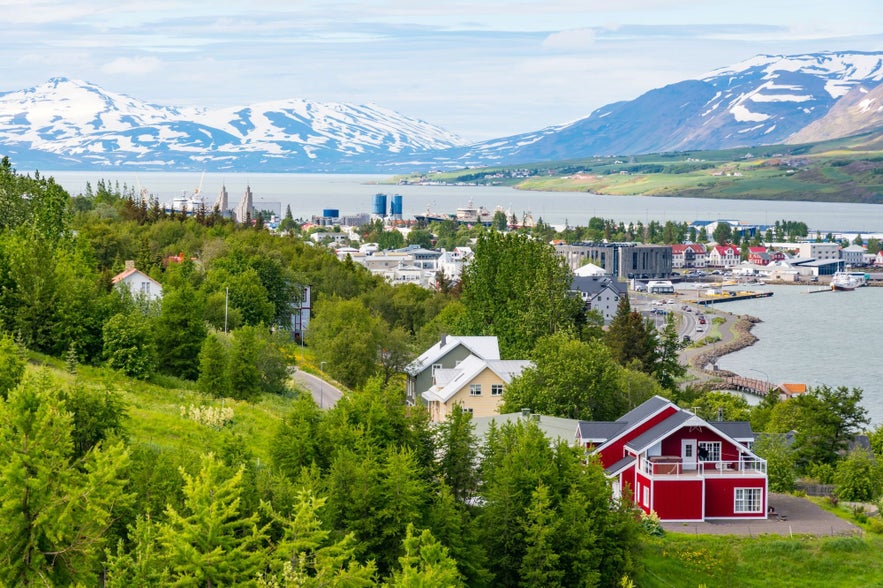 September brings cooler, changing weather to Iceland. Average temperatures range from 42 F to 50 F (6 C to 11 C), with little chance of snow but frequent rain and wind. Low-pressure systems often pass through, especially in the south, so check daily forecasts for weather alerts.
September brings cooler, changing weather to Iceland. Average temperatures range from 42 F to 50 F (6 C to 11 C), with little chance of snow but frequent rain and wind. Low-pressure systems often pass through, especially in the south, so check daily forecasts for weather alerts.
Reykjavik tends to be slightly milder than rural areas. Daylight continues to shorten, dropping from about 13.5 to 11.5 hours by month’s end. As nights grow darker, your chances of seeing the northern lights increase. Be ready for mixed conditions and pack waterproof layers when visiting Iceland in September.
Iceland Weather in October
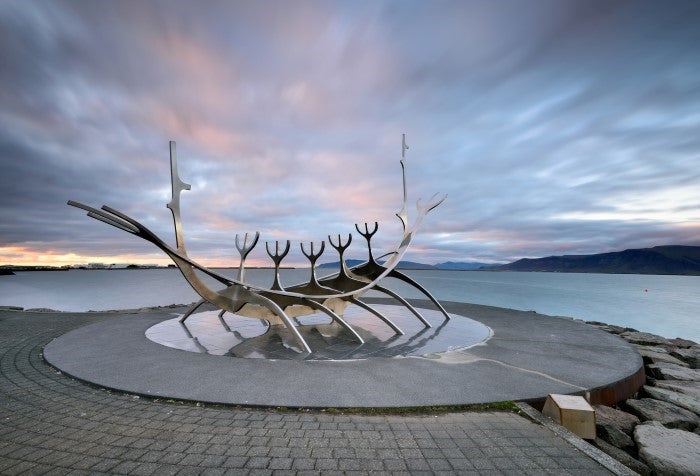
Rain is frequent, making Iceland's weather in October one of the wettest of the year. Waterproof clothing is essential for staying dry and comfortable. Strong winds are also common, and snow may start to appear later in the month. Daylight fades quickly during October in Iceland, dropping from nearly 11.5 hours at the beginning of the month to around 8 hours by the end.
Iceland Weather in November
 November in Iceland brings colder days, rising precipitation, and limited daylight. Average temperatures in Reykjavik range from 33 F to 46 F (1 C to 8 C), with lower temperatures in northern regions. Rain, sleet, and snowfall are all common, and snow in Reykjavik increases significantly compared to October.
November in Iceland brings colder days, rising precipitation, and limited daylight. Average temperatures in Reykjavik range from 33 F to 46 F (1 C to 8 C), with lower temperatures in northern regions. Rain, sleet, and snowfall are all common, and snow in Reykjavik increases significantly compared to October.
Daylight drops quickly, going from about eight hours at the start of the month to only five by the end. The weather can shift quickly, so waterproof gear and thermal layers are essential.
Iceland Weather in December
 December is one of the coldest and wettest months in Iceland. Average temperatures in Iceland range between 34 F and 39 F (1 C to 4 C), with frequent snow and strong winds, especially outside Reykjavik. The capital is slightly milder due to shelter from buildings and heated streets that help melt snow.
December is one of the coldest and wettest months in Iceland. Average temperatures in Iceland range between 34 F and 39 F (1 C to 4 C), with frequent snow and strong winds, especially outside Reykjavik. The capital is slightly milder due to shelter from buildings and heated streets that help melt snow.
Expect around 3.8 inches (97 mm) of precipitation and very limited daylight. This makes December in Iceland perfect for spotting the northern lights. Dress in warm, waterproof layers and check daily forecasts and road conditions before heading out.
The Northern Lights in Iceland
You can best see the northern lights in Iceland between September and March. It's impossible to see the northern lights at the height of summer (June-July) because of Iceland's midnight sun when the night sky stays bright.
By August, nights start to get darker, and you can occasionally spot the northern lights. The "season" for the best aurora hunting is from September to March, when the nights are dark for a substantial amount of time.
From time to time, the northern lights are particularly active. For example, in 2013, there was a solar maximum, and spectacular displays were seen. Another solar maximum is occurring in winter 2025, making this year an excellent time to visit Iceland for a better chance of seeing the aurora.
The Icelandic Meteorological Office has a very reliable northern light forecast for Iceland on its website. This report shows you their predictions for where and how strong the aurora activity will be at a given time and area. The white parts of the forecast signify clear skies, which is the best time to see the northern lights.

FAQs About Weather in Iceland
 Planning a trip to Iceland means preparing for a wide range of weather conditions. This section offers clear, helpful insights into the commonly asked questions about weather in Iceland.
Planning a trip to Iceland means preparing for a wide range of weather conditions. This section offers clear, helpful insights into the commonly asked questions about weather in Iceland.
What is the average temperature in Iceland?
The average temperature in Iceland varies by season and region. In Reykjavik, summer temperatures range from 50 F to 59 F (10 C to 15 C), while winter averages hover around 30 F to 39 F (-1 C to 4 C). Coastal areas are milder due to the ocean’s influence, but the highlands and north can be colder, especially in winter.
When is the best time to visit Iceland?
The best time to visit Iceland depends on your interests. Summer (June to August) offers long daylight hours, green landscapes, and easier travel. Winter (October to March) is ideal for northern lights and ice cave tours. Spring and autumn provide fewer crowds and lower prices.
Is Iceland cold?
Yes, but not as cold as many expect. Coastal regions, including Reykjavik, are warmed by the Gulf Stream, keeping winter temperatures around freezing and summer temperatures between 50 to 59 F (10 to 15 C). While the wind and rain can make it feel colder, especially in open areas, Iceland is generally warmer than other Arctic or Scandinavian destinations. Proper layers make exploring comfortable year-round.
What is the coldest month in Iceland?
January is typically the coldest month in Iceland, with average temperatures around 30 F (-1 C) in Reykjavik. The north and interior highlands often experience colder conditions, with temperatures dropping well below freezing, especially during periods of clear skies and calm winds.
Does Iceland get hot in summer?
Iceland’s summer temperatures are mild rather than hot. Highs typically reach 50 F to 59 F (10 C to 15 C), occasionally rising to 68 F (20 C) during warm spells. The fresh coastal air and long daylight hours make it feel warmer, especially when skies are clear.
Is Iceland's weather unpredictable?
Yes, Iceland’s weather can change rapidly, even within the same hour. Sunshine, rain, wind, and snow may occur on the same day. The island’s location between the Arctic and North Atlantic makes conditions unstable, so dressing in layers and being flexible with plans is essential.
Planning Around Weather in Iceland
 Understanding the weather in Iceland is essential for a smooth and memorable trip. With fast-changing skies, dramatic seasonal contrasts, and unpredictable conditions, the climate plays a major role in shaping every journey. Preparing for summer’s extended daylight or winter’s snowy landscapes helps you make the most of your time in Iceland.
Understanding the weather in Iceland is essential for a smooth and memorable trip. With fast-changing skies, dramatic seasonal contrasts, and unpredictable conditions, the climate plays a major role in shaping every journey. Preparing for summer’s extended daylight or winter’s snowy landscapes helps you make the most of your time in Iceland.
Each season reveals a different side of the island: chilly mornings in spring, golden light stretching through summer nights, bright colors carried on autumn winds, and winter evenings lit by the northern lights. Book your trip to Iceland today and experience the country’s beauty throughout the year.
No matter what time of year you make your trip to Iceland, you're bound to have a unique experience exploring this wonderful country. Have you been to Iceland before? What time of year do you think is the best time to visit? Let us know in the comments below!

